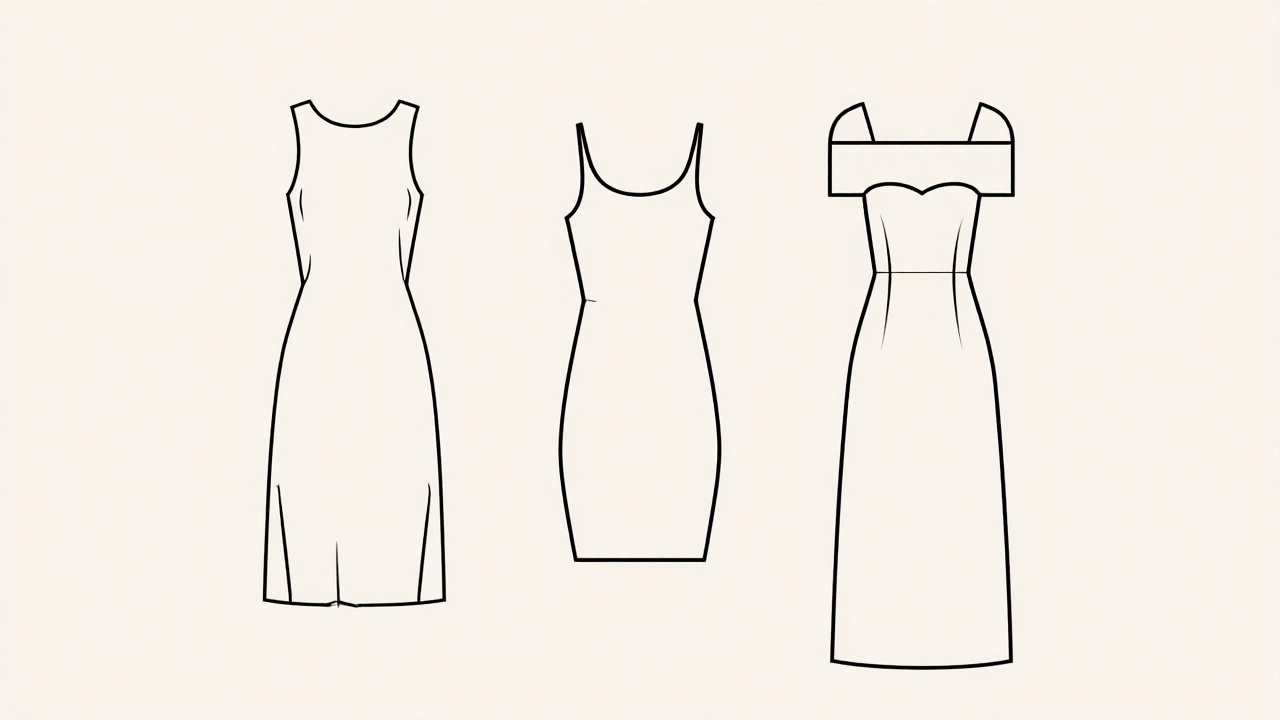What Are Summer Time Dresses Called? Common Names and Styles for Warm-Weather Dresses

Summer Dress Style Finder
Find Your Perfect Summer Dress
Answer these questions to get personalized recommendations for your ideal summer dress style.
Your Best Match
When the sun comes out and the air gets warm, people don’t just want to wear less-they want to wear differently. Summer dresses are the go-to for staying cool, looking fresh, and moving freely. But if you’ve ever stood in front of a rack of summer clothes and wondered, What are these actually called?-you’re not alone. There’s no single name for every dress worn in summer. Instead, there are several popular styles, each with its own look, feel, and name.
Sundress: The Classic Summer Staple
The sundress is the most common term you’ll hear. It’s simple, lightweight, and designed for warmth and sun. Sundresses usually have thin straps, no lining, and are made from cotton, linen, or rayon. They’re often sleeveless or have delicate cap sleeves. You’ll find them in bright colors, stripes, or floral prints. A sundress doesn’t need buttons, zippers, or complicated details. It’s meant to slip on and go.
Think of a sundress as the uniform of beach days, farmers markets, and backyard barbecues. Brands like Free People, Anthropologie, and even Target have entire sections devoted to sundresses. They’re affordable, easy to care for, and work for most body types. If you only buy one summer dress, make it a sundress.
Maxi Dress: Long, Flowy, and Effortless
If you like your dresses long and swinging, you’re probably thinking of a maxi dress. These reach the ankles or floor and are made from light, airy fabrics that move with you. Maxi dresses aren’t just for beach vacations-they’re worn to weddings, dinners, and even casual outings. They often feature V-necks, wrap styles, or empire waists to flatter the figure.
What makes a maxi dress a summer favorite? It covers more skin than a sundress, which helps block UV rays, but still lets air flow. The length also means less need for sunscreen on legs. Many maxi dresses have slits or open backs to keep them from feeling heavy. They’re especially popular in tropical climates and among women who prefer modest but stylish coverage.
Shift Dress: Minimalist and Easy
A shift dress is straight-cut, loose-fitting, and hits anywhere from mid-thigh to just above the knee. It doesn’t cinch at the waist, which makes it ideal for hot days when you don’t want anything tight. Shift dresses are often made from cotton blends or jersey and come in solid colors or simple patterns. You’ll see them in office settings too, but the summer versions are lighter and more colorful.
They’re great for people who want structure without restriction. No belts, no tucks, no fuss. Just a clean line that moves with your body. Brands like COS, Everlane, and Madewell have made shift dresses a modern staple. They’re also easy to layer with a denim jacket or cardigan if the evening gets chilly.

Tank Dress: The Simplest Option
Some summer dresses are just that-dresses with tank top sleeves. These are called tank dresses. They’re similar to sundresses but with wider, more structured straps that look like a tank top. The fabric is usually thin and breathable, and the cut is often boxy or slightly A-line.
Tank dresses are popular because they’re low-maintenance. No need to worry about straps slipping or adjusting. They’re also great for layering under open shirts or vests. You’ll find them in everything from solid navy to bold tie-dye. They work for running errands, traveling, or lounging by the pool. If you want a dress that looks like it was made for doing nothing, a tank dress is your pick.
Floral Dress: A Seasonal Favorite
Floral prints dominate summer fashion every year. But a floral dress isn’t a style-it’s a pattern. You can find floral prints on sundresses, maxi dresses, shift dresses, and tank dresses. The key is how the print is used. Small, scattered blooms give a romantic, cottagecore feel. Large, bold florals make a statement. Dark backgrounds with bright flowers look more sophisticated.
Floral dresses became a summer staple in the 1960s and never left. They’re tied to memories of vacations, gardens, and warm evenings. Designers like Diane von Furstenberg and Lilly Pulitzer made them iconic. Today, you’ll find them everywhere-from high-end boutiques to discount stores. The trick? Match the scale of the print to your body type. Large prints on petite frames can overwhelm; small prints on taller frames can get lost.
Other Summer Dress Styles You Might See
Not every summer dress fits neatly into one category. Here are a few others you’ll come across:
- Fit-and-flare: Snug at the top, flares out at the hips-great for hiding the midsection.
- Slip dress: Made of satin or silk, often worn over a camisole. More dressy, but still perfect for warm nights.
- Off-shoulder dress: Shows the collarbones and shoulders. Very popular for summer weddings and parties.
- Peasant dress: Features puffed sleeves, embroidery, and a loose fit. Has a bohemian vibe.
These styles overlap. A peasant dress can also be a maxi. A slip dress can be a sundress if it’s made of cotton. The names are more about guiding your search than strict rules.

How to Choose the Right One for You
Not all summer dresses suit every body or lifestyle. Here’s how to pick:
- Think about your daily life. If you’re on your feet all day, go for a sundress or tank dress. If you work in an office, a shift dress in a solid color works best.
- Consider your climate. In humid areas, choose natural fibers like cotton or linen. In dry heat, rayon or silk can be fine too.
- Match the occasion. A floral maxi works for a picnic. A slip dress works for a dinner date. A tank dress works for grocery runs.
- Try it with shoes. Sandals? Espadrilles? Barefoot? The right dress pairs with the right footwear. A maxi dress looks off with chunky sneakers.
There’s no single ‘best’ summer dress. The right one is the one you feel comfortable in. That’s the real rule.
What to Avoid
Some styles look great on the hanger but don’t work in real life. Avoid:
- Dresses made of polyester or synthetic blends-they trap heat and sweat.
- Too-tight waistbands or boning-they’re meant for cooler weather.
- Heavy lace or ruffles-they add bulk and don’t breathe.
- Dark colors like black or navy in direct sun-they absorb heat.
Stick to light colors, loose fits, and natural materials. That’s the summer dress formula.
Are sundresses and summer dresses the same thing?
Almost all sundresses are summer dresses, but not all summer dresses are sundresses. Sundresses are a specific type-lightweight, strapless or thin-strapped, and usually casual. Summer dresses include sundresses, maxis, shifts, tank dresses, and more. So sundress is a subset of summer dress.
What’s the difference between a maxi dress and a long dress?
A maxi dress is a long dress, but not all long dresses are maxis. Maxi dresses are specifically designed for warm weather, made of light fabrics, and often have flowy silhouettes. A long dress could be a formal gown, a wedding dress, or a winter coat dress-all of which are too heavy or too structured for summer. So the term ‘maxi’ tells you it’s meant for heat.
Can you wear a summer dress in the fall?
Yes, if you layer smartly. A sundress or shift dress under a denim jacket, cardigan, or lightweight coat works perfectly in early fall. Add tights or ankle boots, and you’re set. Many people extend their summer dress season by wearing them into October, especially in warmer regions.
Why are floral prints so common in summer dresses?
Floral prints are linked to nature, growth, and warmth-things we associate with summer. They’ve been popular since the 1960s, when designers used them to evoke freedom and vacation vibes. Today, they’re still a safe bet because they’re cheerful, versatile, and work with most skin tones. Plus, they’re easy to print on lightweight fabrics.
Do I need to buy a new summer dress every year?
No. Summer dresses are timeless if you choose well. Stick to classic styles like sundresses, shifts, and simple maxis in neutral or solid colors. These last for years. Trendy prints and tight cuts go out of style fast. Invest in quality fabric and simple cuts-you’ll wear them longer and feel better in them.
Final Thought
Summer dresses aren’t just clothing-they’re a way of moving through the season. They’re tied to memories of sunshine, bare feet on grass, and slow evenings. The names-sundress, maxi, shift, tank-help you find what you need. But the real reason you wear them? Because they make you feel light, free, and alive. That’s more than fashion. That’s comfort.